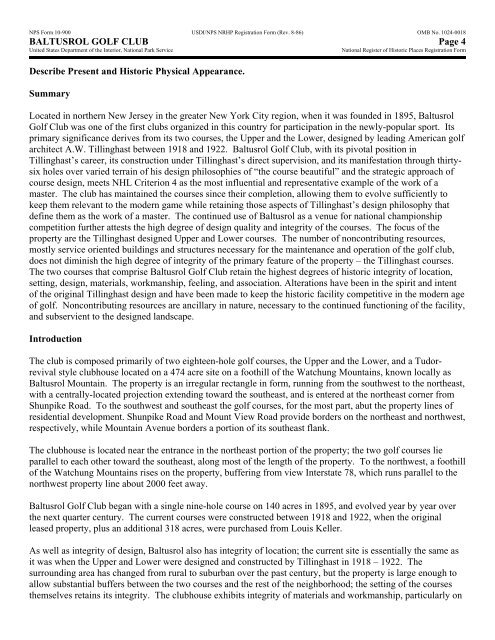Nomination - National Park Service
Nomination - National Park Service
Nomination - National Park Service
You also want an ePaper? Increase the reach of your titles
YUMPU automatically turns print PDFs into web optimized ePapers that Google loves.
NPS Form 10-900 USDI/NPS NRHP Registration Form (Rev. 8-86) OMB No. 1024-0018<br />
BALTUSROL GOLF CLUB Page 4<br />
United States Department of the Interior, <strong>National</strong> <strong>Park</strong> <strong>Service</strong><br />
<strong>National</strong> Register of Historic Places Registration Form<br />
Describe Present and Historic Physical Appearance.<br />
Summary<br />
Located in northern New Jersey in the greater New York City region, when it was founded in 1895, Baltusrol<br />
Golf Club was one of the first clubs organized in this country for participation in the newly-popular sport. Its<br />
primary significance derives from its two courses, the Upper and the Lower, designed by leading American golf<br />
architect A.W. Tillinghast between 1918 and 1922. Baltusrol Golf Club, with its pivotal position in<br />
Tillinghast’s career, its construction under Tillinghast’s direct supervision, and its manifestation through thirtysix<br />
holes over varied terrain of his design philosophies of “the course beautiful” and the strategic approach of<br />
course design, meets NHL Criterion 4 as the most influential and representative example of the work of a<br />
master. The club has maintained the courses since their completion, allowing them to evolve sufficiently to<br />
keep them relevant to the modern game while retaining those aspects of Tillinghast’s design philosophy that<br />
define them as the work of a master. The continued use of Baltusrol as a venue for national championship<br />
competition further attests the high degree of design quality and integrity of the courses. The focus of the<br />
property are the Tillinghast designed Upper and Lower courses. The number of noncontributing resources,<br />
mostly service oriented buildings and structures necessary for the maintenance and operation of the golf club,<br />
does not diminish the high degree of integrity of the primary feature of the property – the Tillinghast courses.<br />
The two courses that comprise Baltusrol Golf Club retain the highest degrees of historic integrity of location,<br />
setting, design, materials, workmanship, feeling, and association. Alterations have been in the spirit and intent<br />
of the original Tillinghast design and have been made to keep the historic facility competitive in the modern age<br />
of golf. Noncontributing resources are ancillary in nature, necessary to the continued functioning of the facility,<br />
and subservient to the designed landscape.<br />
Introduction<br />
The club is composed primarily of two eighteen-hole golf courses, the Upper and the Lower, and a Tudorrevival<br />
style clubhouse located on a 474 acre site on a foothill of the Watchung Mountains, known locally as<br />
Baltusrol Mountain. The property is an irregular rectangle in form, running from the southwest to the northeast,<br />
with a centrally-located projection extending toward the southeast, and is entered at the northeast corner from<br />
Shunpike Road. To the southwest and southeast the golf courses, for the most part, abut the property lines of<br />
residential development. Shunpike Road and Mount View Road provide borders on the northeast and northwest,<br />
respectively, while Mountain Avenue borders a portion of its southeast flank.<br />
The clubhouse is located near the entrance in the northeast portion of the property; the two golf courses lie<br />
parallel to each other toward the southeast, along most of the length of the property. To the northwest, a foothill<br />
of the Watchung Mountains rises on the property, buffering from view Interstate 78, which runs parallel to the<br />
northwest property line about 2000 feet away.<br />
Baltusrol Golf Club began with a single nine-hole course on 140 acres in 1895, and evolved year by year over<br />
the next quarter century. The current courses were constructed between 1918 and 1922, when the original<br />
leased property, plus an additional 318 acres, were purchased from Louis Keller.<br />
As well as integrity of design, Baltusrol also has integrity of location; the current site is essentially the same as<br />
it was when the Upper and Lower were designed and constructed by Tillinghast in 1918 – 1922. The<br />
surrounding area has changed from rural to suburban over the past century, but the property is large enough to<br />
allow substantial buffers between the two courses and the rest of the neighborhood; the setting of the courses<br />
themselves retains its integrity. The clubhouse exhibits integrity of materials and workmanship, particularly on
















